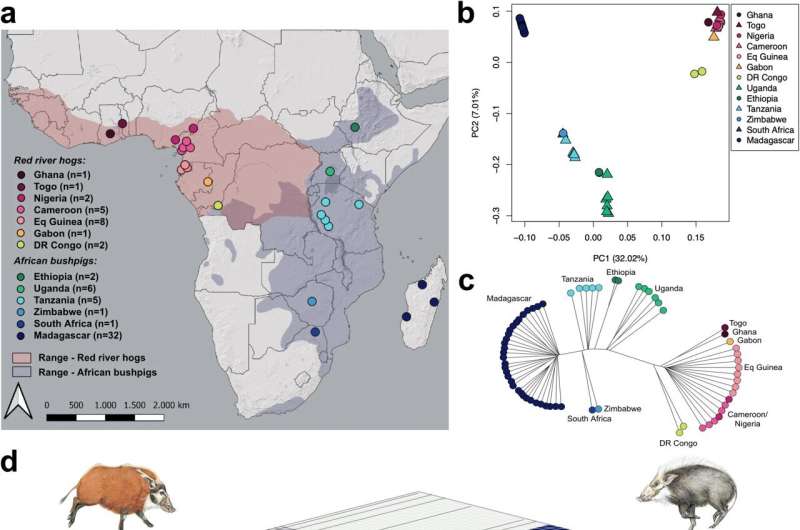This article has been reviewed according to Science X's editorial process and policies. Editors have highlighted the following attributes while ensuring the content's credibility:
fact-checked
peer-reviewed publication
trusted source
proofread
How did the bushpig cross the strait? A great puzzle in African mammal biogeography solved by genomics

In the ongoing biodiversity crisis, large terrestrial animals are more threatened by extinction than any other group of organisms. The African continent holds an impressively intact large-mammal community, but there is still a lot we do not know about how these species evolved, became diverse, and adapted to the changing climate and habitats. Many of these questions can be addressed by investigating the genomes and genetic variation across species.
New research, published in Nature Communications, uses genomics to answer these evolutionary questions that have been debated among scientists for decades: 1) how and when did bushpigs cross the Mozambique Channel and arrive at the island of Madagascar, 2) is there one or two species of bushpigs?
"This study is a result of a large international collaboration with researchers from Africa and Europe. We sequenced 67 complete bushpig genomes, and by using a range of different genetic analyses, we were able to address these long-standing puzzles in African evolution and biogeography," explains one of the senior authors of the study, Associate Professor at the Department of Biology, Rasmus Heller.
Were pigs ferried across the channel during the Medieval era?
The island of Madagascar separated from the African mainland around 160 million years ago, resulting in a largely unique flora and fauna. Remarkably, the bushpig is the only large, wild terrestrial mammal species that has historically crossed the 400-kilometer-wide Mozambique Channel and made it from mainland Africa to Madagascar.
"Our study establishes that the bushpig was introduced to Madagascar ≈1,000-5,000 years ago from South/South-East Africa," Rasmus states. Their arrival, therefore, coincides with the arrival of humans to Madagascar from a region around southern Africa.
Rasmus continues, "The likely explanation for this is that people transported these bushpigs across the channel. These results contradict previously published studies which dated the arrival of bushpigs ≈480,000 years ago, well before humans were present on the island." It has been suggested that some endemic Madagascar species might have arrived by rafting as passengers on vegetation floats.
"Intriguingly, our results raise a host of new questions: was the bushpig actually brought to Madagascar as a somewhat domesticated species? There is no archaeological or other evidence of bushpig domestication ever occurring despite them being an important source of protein for many rural communities."
"And who was it that transported these animals to Madagascar? Was it Bantu speakers, Austronesian speakers, or both? These questions and others still remain to be explored," explains Renzo F. Balboa, a postdoc at the Department of Biology and one of the leading authors of the study.
Does two actually equal one?
African bushpigs, which primarily are found in East/Southern Africa, and red river hogs, which are found in West/Central Africa, were considered the same species in the past but were subsequently redefined as two species around the 1990s, largely due to their quite distinctive looks.
The red river hogs are, as the name implies, red and have long, tufted ears reminiscent of a comical Star Wars character, while eastern and southern African bushpigs are grayish and look more like our own wild boar, although with a beautiful white mane thrown in for good measure.
Biologists have been arguing for decades about whether these two forms are actually one or two different species—a debate that is characteristic of similar scientific uncertainty surrounding many other African mammals.
"In this study, we were able to conclude that red river hogs and bushpigs have had lots of gene flow, which means they are not only able to interbreed potentially, but they have, in fact, done so extensively when they have met in central Africa. Furthermore, the branching of the two types in the Tree of Life is not all that old, only a few hundred thousand years, which is not long in the evolutionary scheme of things."
"Hence, we now know that although there are two quite different-looking lineages of bushpigs, their biological separation is incomplete, depending on how you define species," explains Laura D. Bertola, a postdoc at the Department of Biology and the other leading author of the study.
Laura continues, "Genomic data can give us insights into patterns of biodiversity on a much higher resolution than previously possible. For example, we can infer detailed population structure, but also underlying processes like gene flow and selection. Gaining improved insights into patterns of biodiversity and the underlying processes that drive them will be crucial for effective conservation measures."
Africa is a unique continent regarding the diversity of the megafauna, which is still around. Studying the evolutionary history of these species can give us important insights into African biodiversity, which is highly relevant at a time when biodiversity is being lost at an alarming pace.
The new findings contribute to our understanding of prehistoric relations between Africa's humans and wildlife and the fundamentals of how much biodiversity there is on this amazing continent.
"This study is a great example of how involving local researchers and wildlife management authorities can lead to more robust and inclusive scientific research," co-author Vincent Muwanika, Associate Professor of Conservation Biology, at Makerere University, Uganda, concludes.
More information: Renzo F. Balboa et al, African bushpigs exhibit porous species boundaries and appeared in Madagascar concurrently with human arrival, Nature Communications (2024). DOI: 10.1038/s41467-023-44105-1
Journal information: Nature Communications
Provided by University of Copenhagen


















